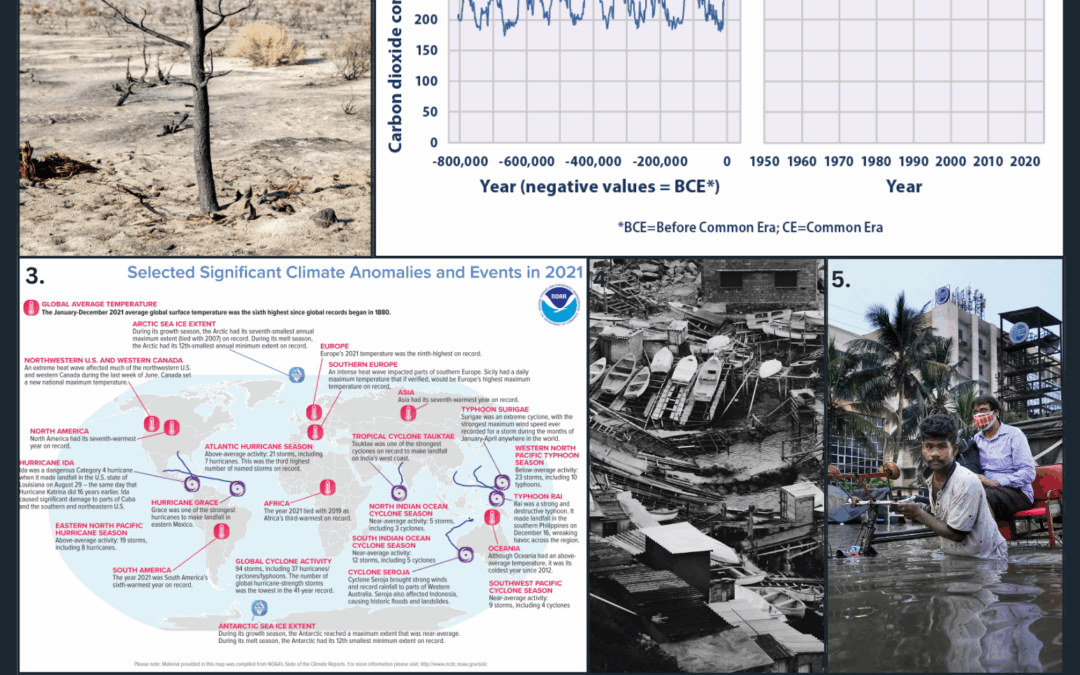Building Futures (BF) is about identifying projects, ideas, and innovations that create lasting positive change within the building community and the communities it serves.
Throughout my professional career, most building projects have relied on the assumption that a functioning “grid” of power, water, sewer, telecommunications, transportation, and internet systems was readily available. Yet, for far too long, these essential networks have been neglected, undermaintained, and rarely replaced when they’ve exceeded their design life. Driving through Chicago in recent years has been both frustrating—because of congestion—and exciting, as major infrastructure renewal is finally visible across highways, rail lines, bridges, and data centers.
This BF explores what defines climate change and why it matters for our built environment.
Understanding Climate Change
The Earth’s climate has changed repeatedly over the ages, but today’s climate change is different. Historically, before 1700—prior to large-scale industrialization and widespread human emissions of greenhouse gases—climate was driven almost entirely by natural factors:
1. Solar Variability
- The Sun’s energy output varies over time due to cycles such as sunspots, subtly influencing global temperatures.
2. Volcanic Activity
- Large eruptions release sulfur dioxide and ash into the stratosphere, forming reflective aerosols that block sunlight, leading to temporary global cooling.
3. Orbital (Milankovitch) Cycles
- Slow changes in Earth’s orbit and tilt affect how sunlight is distributed across the planet, driving ice age and interglacial cycles.
4. Changes in Ice Sheets and Snow Cover (Albedo Feedbacks)
- Expanding ice sheets reflect more sunlight, cooling the Earth; shrinking ice amplifies warming.
5. Ocean Circulation Changes
- Oceans store and redistribute heat. Shifts in currents, like the Atlantic Meridional Overturning Circulation (AMOC), can affect regional and global climate.
6. Natural Greenhouse Gas Variations
- Even before humans, CO₂, methane, and nitrous oxide levels fluctuated due to natural processes, acting as climate amplifiers.
7. Biosphere and Land Surface Changes
- Forest growth and decay, wildfires, and vegetation shifts influenced carbon storage and local climate conditions.
Human Population and Climate Impact
Historically, human populations were dramatically smaller:
- 10,000 BC: 1–10 million
- 1700 AD: ~640 million (median estimate)
- 2025 AD: ~8.2 billion
This represents a 1,640% increase in population since 1700, made possible by advances in agriculture, healthcare, building, industry, and technology. Alongside population growth, human activity, including energy production, transportation, agriculture, healthcare, and industry, has significantly altered the natural environment.
Today, climate change discussions focus on human-driven factors, primarily:
- Greenhouse gases: carbon dioxide, methane, nitrous oxide, and halogenated gases
- Sources: The greenhouse gases are being created from numerous human industries including; transportation, energy production, agriculture, building, and industry

Climate Change and the Built Environment
While media often frames climate change in apocalyptic terms, the Earth itself will continue. The real challenges affect humanity, particularly our built environments: cities, towns, villages, and infrastructure particularly those located alongside rivers, lakes, and coasts.
For millennia, humans have settled near waterways for food, water, and transportation. As the climate shifts, storms intensify, and temperature extremes become more common, the infrastructure, communities, and ecosystems in these areas face increasing stress, sometimes life-threatening.
Image 1: Mono Lake, California (09/20/2020); Photo by Nikolay Maslov on Unsplash
Image 2: Atmospheric Concentration C02 (June 2024); Image by Environment Protection Agency
Image 3: Climate Anomalies; Image by National Oceanic and Atmospheric Administration
Image 4: Arraial do Cabo, RJ, Brasil (11/06/2020); Photo by Jonathan Borba on Unsplash
Image 5: Kolkata, West Bengal, India (10/21/2021); Photo by Dibakar Roy on Unsplash
